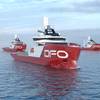European shipowners hope that the momentum created by the Dutch Presidency’s High Level Event on Short Sea Shipping held in Amsterdam last February will result in maritime directors putting Short Sea Shipping on the top priority list when they meet today in Brussels.
“At the Dutch Presidency event, all participants strongly agreed on the need and urgency to finally remove all barriers. The lack of a single market, cumbersome administrative procedures, market access restrictions for service providers in ports and other barriers makes short sea shipping less competitive and also less attractive than other transport modes”, commented European Community Shipowners’ Associations (ECSA) Secretary General Patrick Verhoeven.
“This is regrettable given that short sea shipping has the potential to respond in a safe, sustainable, efficient and cost-effective manner to expected growth in transport demand”, he added.
EU shipping policy has so far not delivered on its promise to create a single market for shipping. Short sea shipping remains disadvantaged compared to other transport modes. In many cases, goods transported by short sea shipping between two EU seaports lose Union status as soon as they leave port.
This entails a heavy administrative burden, involving several authorities and intermediate parties. Procedures and requirements are not only complex but also repetitive, resulting in productivity losses and unnecessary workload and stress for ship crews.
“We call upon all legislators to have a “short sea reflex”, said Patrick Verhoeven. “We see too often legislation that has, unintended, negative consequences for short sea shipping. Unfortunately there is again such an example. This time we fear the risk of competition between transport modes and even modal backshift following the International Maritime Organisation’s SOLAS rules on weighing of containers. While these new IMO rules as such are very much applauded by shipowners, we are concerned about the impact it has on short sea LO-LO shipping”, he continued.
Containers which are loaded onto a vessel are required to comply with all new procedures, whereas those placed on a truck to be driven on board a vessel or take a landside connection do not. Therefore the cost of moving a container via a LO-LO (lift-on/lift-off) vessel may increase and lead-time may become longer. This could drive users to opt for an alternative solution.
“We would certainly want this distortion to be solved as soon as possible as from a safety perspective we see no reason for this different treatment within the short sea segment and we are convinced that nobody intended to create a modal backshift with these rules”, Patrick Verhoeven concluded.










